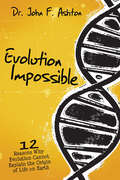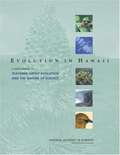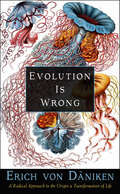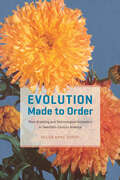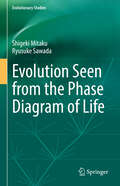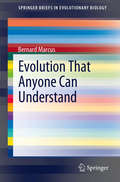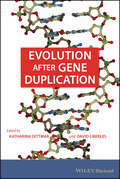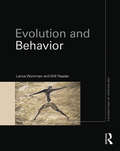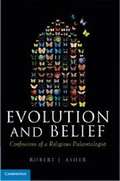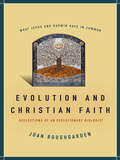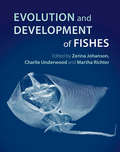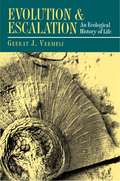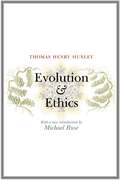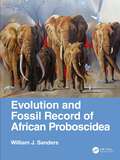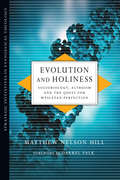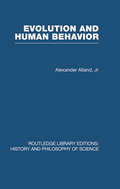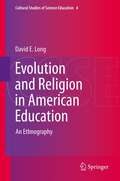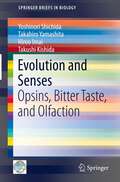- Table View
- List View
Evolution Impossible: 12 Reasons Why Evolution Cannot Explain the Origin of Life on Earth
by John AshtonThere is scientific evidence proving evolution cannot be responsible for life on Earth. It is time to question what biology text books and nature documentaries claim about our origins. Even Darwin admitted, "I threw out queries, suggestions, wondering all the time over everything; and to my astonishment the ideas took like wildfire. People made a religion of them." Dr. John Ashton has dedicated 40+ years to teaching and researching science, and exposing the lack of proven evidence for Darwin's theories. In Evolution Impossible, he uses discoveries in genetics, biochemistry, geology, radiometric dating, and other scientific disciplines to explain why the theory of evolution is a myth. Discover for yourself: Why the fossil record is evidence of extinction, not evolution How erosion and sedimentation dates conflict with radiometric dating How the lack of transitional fossils undermines evolutionary notions Why living cells and new organisms do not rise by chance or random mutations Regardless of your level of scientific education, you will finish this book able to cite 12 reasons why evolution cannot explain the origin of life.
Evolution In Hawaii: A Supplement To Teaching About Evolution And The Nature Of Science
by Steve OlsonAs both individuals and societies, we are making decisions today that will have profound consequences for future generations. From preserving the earth’s plants and animals to altering our use of fossil fuels – none of these decisions can be made wisely without a thorough understanding of life’s history on our planet through biological evolution. Companion to the best selling title Teaching About Evolution and the Nature of Science, Evolution in Hawaii examines evolution and the nature of science by looking at a specific part of the world. Tracing the evolutionary pathways in Hawaii, we are able to draw powerful conclusions about evolution’s occurrence, mechanisms, and courses. This practical book has been specifically designed to give teachers and their students an opportunity to gain a deeper understanding of evolution using exercises with real genetic data to explore and investigate speciation and the probable order in which speciation occurred based on the ages of the Hawaiian Islands. By focusing on one set of islands, this book illuminates the general principles of evolutionary biology and demonstrate how ongoing research will continue to expand our knowledge of the natural world.
Evolution Inclusions and Variation Inequalities for Earth Data Processing III
by Mikhail Z. Zgurovsky Pavlo O. Kasyanov José Valero Nina V. Zadoianchuk Oleksiy V. KapustyanIn this sequel to two earlier volumes, the authors now focus on the long-time behavior of evolution inclusions, based on the theory of extremal solutions to differential-operator problems. This approach is used to solve problems in climate research, geophysics, aerohydrodynamics, chemical kinetics or fluid dynamics. As in the previous volumes, the authors present a toolbox of mathematical equations. The book is based on seminars and lecture courses on multi-valued and non-linear analysis and their geophysical application.
Evolution Is Wrong: A Radical Approach to the Origin and Transformation of Life (Erich von Daniken Library)
by Erich von DänikenA Fascinating Exploration on Why the Darwinists’ Theory No Longer Explains EverythingThere was once a set of ideas called the theory of evolution, conceived by clever people and confirmed by countless scientists. Then people discovered the electron microscope. This made it possible to make the molecules within the cell visible, and suddenly questions about evolution arose that were not possible before. Which force actually bundles the atoms in the right order? What moves the molecular chains into the correct position? How did the first living unit within the cell actually come about? How does inheritance work, how does information pass on to the next generation? Did humans descend only and exclusively from primates—as Charles Darwin and countless other great minds assumed—or did additional “engines” intervene in evolution? Today it is clear: countless questions can no longer be answered with the previous theory of evolution. There is a form of life called “Blob” (Physarum polycephalum). The “thing” has neither eyes nor ears, neither a mouth nor a nose or even a brain. Nevertheless, it takes in food, overcomes obstacles by the shortest route and exchanges information with other “blobs.” The “blob” contradicts any evolutionary thought that one develops from the other. Or the “gastric-brooding frogs” (Rheobatrachus) found in Australia. They hatch their young in the stomach. Impossible in a slow, evolutionary process. Everywhere there are characteristics of animals that do not want to fit into the theory of evolution anywhere. And man? Are we really the most adapted life-form on this planet? Today, more and more scientists who contradict the previous theory of evolution speak out. The theory fits the changes within the species, but it can no longer be reconciled with the inner workings of the cell. Some other influence that has so far escaped us is affecting evolution. It is called “Intelligent Design.” Intelligent planning is suspected behind this. Anyone or anything—a spirit of the universe? Aliens?—could be behind this planning. Erich von Däniken uses countless examples to demonstrate the impossibility of the previous evolutionary idea. He quotes scientists who argue against the previous teaching, but also those who defend it. Unfortunately, established science still refuses to look at discrepancies and holes in the theory of evolution, even though it is quite obvious that there is more going on with regard to the development of all species, as well as human culture, than could be explained by the theory of evolution alone.
Evolution Made to Order: Plant Breeding and Technological Innovation in Twentieth-Century America
by Helen AnnePlant breeders have long sought technologies to extend human control over nature. Early in the twentieth century, this led some to experiment with startlingly strange tools like x-ray machines, chromosome-altering chemicals, and radioactive elements. Contemporary reports celebrated these mutation-inducing methods as ways of generating variation in plants on demand. Speeding up evolution, they imagined, would allow breeders to genetically engineer crops and flowers to order. Creating a new food crop or garden flower would soon be as straightforward as innovating any other modern industrial product. In Evolution Made to Order, Helen Anne Curry traces the history of America’s pursuit of tools that could intervene in evolution. An immersive journey through the scientific and social worlds of midcentury genetics and plant breeding and a compelling exploration of American cultures of innovation, Evolution Made to Order provides vital historical context for current worldwide ethical and policy debates over genetic engineering.
Evolution Mechanism on Structural Characteristics of Lead-Contaminated Soil in the Solidification/Stabilization Process (Springer Theses)
by Jiang-Shan LiThis book highlights the use of Solidification/Stabilization (S/S) to treat lead-contaminated soils, which are widely present in China. It reveals the evolutionary mechanism of the structural characteristics of Pb contaminated soil during the S/S process. In addition, the book systematically analyzes laws influencing the S/S process and its internal mechanisms, and develops new models for the strength prediction and Pb leaching prediction of S/S monolith. The results can provide essential theoretical guidance and parameter-related support for the design of Pb-contamiated soil S/S remediation and recycling solutions.
Evolution Seen from the Phase Diagram of Life (Evolutionary Studies)
by Shigeki Mitaku Ryusuke SawadaThis book aims to understand biological evolution through a physical approach, focusing on the macroscopic aspects of the biological genome. Readers will discover the connection between genomic information and the harmony of biological systems, a relationship that remains elusive to many researchers in biological sciences.The most common approach to understanding living organisms with physics is to begin with a single molecule of an organism. In contrast to this bottom-up approach, building from each molecule to the whole, this book takes a coarse-grained approach at the amino acid level to physically understand the macroscopic aspects of the organism. The book presents a system developed by the authors to predict membrane proteins with high accuracy using only physical parameters. Another distinctive perspective of this book is that it proposes the idea of a physical mechanism, other than natural selection, that orchestrates the emergence of order from random processes. The study of macroscopic aspects of living organisms based on this concept has parallels with thermostatistical mechanics for states of matter. Just as random processes create order in matter, there are physical random processes that form order in living organisms. This analogy is the central theme of the book.Using terms and analogies familiar to physicists, the book bridges the gap between biological and physical sciences. The book focuses on simple principles and is aimed primarily at researchers. While the content of this book is at the boundary area of biophysics, soft matter physics and bioinformatics, it will also be of interest to researchers and graduate students working on any biological topics.
Evolution Talk: The Who, What, Why, and How behind the Oldest Story Ever Told
by Rick CosteEvolution helps us understand our humble place in the rich tapestry of life. But what do we know about the theory of evolution itself? In this captivating book based on his popular podcast, Rick Coste reveals how the theory of evolution came to be and how it explains the world around us.Before Charles Darwin, other luminaries planted the seeds of the theory that would one day make him famous. Evolution Talk begins by shining a spotlight on the writers, philosophers, and scientists who cultivated the concepts and speculations that blossomed into the theory of evolution by natural selection, from Aristotle&’s big ideas to a young fossil hunter named Mary Anning, whose discovery of the first ichthyosaur skeleton changed everything. After exploring the contributions of Charles Darwin and Alfred Russel Wallace, Evolution Talk investigates the very beginnings of life itself. From its genesis in a primordial pond to the endless and beautiful forms which emerged to populate our once inhospitable and barren little planet. Along the way, adaptations such as altruism, sexual selection, and the development of brains further pushed life along its amazing path to where it is today. Finally, Coste concludes by taking a step back to ask questions about how we as humans fit in, such as &“Are we unique?&” and &“Are we still evolving?&”Breaking down complex concepts with easy-to-follow language and engaging examples, Evolution Talk will educate and entertain any reader looking to learn more about the greatest idea ever.
Evolution That Anyone Can Understand
by Bernard MarcusThe function of scientific research is promoting the understanding of the world around us. In theory, anyway, the more we learn, the more potential we have of making our lives better. Thus, we have seen research in electronics provide us with computers, research in chemistry provide us with all manner of synthetics, and research in agriculture provide us with more food. Periodically, scientific research uncovers something that makes some of us uncomfortable. The discovery of the link between smoking and lung cancer and heart disease was not received well by the tobacco industry, and the link between global climate change and fossil fuel use has not been well received by the petroleum industry, to cite just two examples. Usually the response of those whose world has been disrupted by science is denial, often followed by attack on or ridicule of the science that has challenged them. In the long term, however, science usually turns out to be correct.
Evolution after Gene Duplication
by David Liberles Katharina DittmarGene duplication has long been believed to have played a major role in the rise of biological novelty through evolution of new function and gene expression patterns. The first book to examine gene duplication across all levels of biological organization, Evolution after Gene Duplication presents a comprehensive picture of the mechanistic process by which gene duplication may have played a role in generating biodiversity. Key Features: Explores comparative genomics, genome evolution studies and analysis of multi-gene families such as Hox, globins, olfactory receptors and MHC (immune system) A complete post-genome treatment of the topic originally covered by Ohno's 1970 classic, this volume extends coverage to include the fate of associated regulatory pathways Taps the significant increase in multi-gene family data that has resulted from comparative genomics Comprehensive coverage that includes opposing theoretical viewpoints, comparative genomics data, theoretical and empirical evidence and the role of bioinformatics in the study of gene duplication This up-to-date overview of theory and mathematical models along with practical examples is suitable for scientists across various levels of biology as well as instructors and graduate students.
Evolution and Behavior
by Lance Workman Will ReaderThe relationship between how we evolved and how we behave is a controversial and fascinating field of study. From how we choose a mate to how we socialize with other people, the evolutionary process has an enduring legacy on the way we view the world. Evolution and Behavior provides students with a thorough and accessible introduction to this growing discipline. Placing evolutionary psychology in context with the core areas of psychology – developmental, cognitive and social – the book explores some of the most fundamental questions we can ask about ourselves. Taking students through the principles of natural selection, it provides a nuanced understanding of key topics such as: cognitive development and the role of intelligence, memory, emotions and perception, mental health and abnormal psychology, sexual reproduction and family relationships, the development of culture. Addressing a number of controversial debates in the field, each chapter also includes concept boxes, the definition of key terms, chapter summaries and further reading. This is the ideal introductory textbook for anyone interested in evolutionary psychology. It will provide not only an essential overview of this emerging field, but also deepen readers’ appreciation of the core tenets of psychology as a whole.
Evolution and Belief
by Robert J. AsherCan a scientist believe in God? Does the ongoing debate between some evolutionists and evangelicals show that the two sides are irreconcilable? As a paleontologist and a religious believer, Robert Asher constantly confronts the perceived conflict between his occupation and his faith. In the course of his scientific work, he has found that no other theory comes close to Darwin's as an explanation for our world's incredible biodiversity. Recounting discoveries in molecular biology, paleontology and development, Asher reveals the remarkable evidence in favor of Darwinian evolution. In outlining the scope of Darwin's idea, Asher shows how evolution describes the cause of biodiversity, rather than the agency behind it. He draws a line between superstition and religion, recognizing that atheism is not the inevitable conclusion of evolutionary theory. By liberating evolution from its misappropriated religious implications, Asher promotes a balanced awareness that contributes to our understanding of biology and Earth history.
Evolution and Christian Faith: Reflections of an Evolutionary Biologist
by Joan RoughgardenClick here to visit evolutionandchristianfaith.org "I'm an evolutionary biologist and a Christian," states Stanford professor Joan Roughgarden at the outset of her groundbreaking new book, Evolution and Christian Faith: Reflections of an Evolutionary Biologist. From that perspective, she offers an elegant, deeply satisfying reconciliation of the theory of evolution and the wisdom of the Bible. Perhaps only someone with Roughgarden's unique academic standing could examine so well controversial issues such as the teaching of intelligent design in public schools, or the potential flaws in Darwin's theory of evolution. Certainly Roughgarden is uniquely suited to reference both the minutiae of scientific processes and the implication of Biblical verses. Whether the topic is mutation rates and lizards or the hidden meanings behind St. Paul's letters, Evolution and Christian Faith distils complex arguments into everyday understanding. Roughgarden has scoured the Bible and scanned the natural world, finding examples time and again, not of conflict, but of harmony. The result is an accessible and intelligent context for a Christian vision of the world that embraces science. In the ongoing debates over creationism and evolution, Evolution and Christian Faith will be seen as a work of major significance, written for contemporary readers who wonder how-or if-they can embrace scientific advances while maintaining their traditional values.
Evolution and Development of Fishes
by Zerina Johanson Charlie Underwood Martha RichterFish, or lower vertebrates, occupy the basal nodes of the vertebrate phylogeny, and are therefore crucial in interpreting almost every feature of more advanced vertebrates, including amphibians, reptiles, birds and mammals. Recent research focuses on combining evolutionary observations - primarily from the fish fossil record - with developmental data from living fishes, in order to better interpret evolutionary history and vertebrate phylogeny. This book highlights the importance of this research in the interpretation of vertebrate evolution, bringing together world-class palaeontologists and biologists to summarise the most interesting, current and cutting-edge topics in fish evolution and development. It will be an invaluable tool for researchers in early vertebrate palaeontology and evolution, and those particularly interested in the interface between evolution and development.
Evolution and Escalation: An Ecological History of Life
by Geerat J. VermeijHere is one biologist's interpretation of the chronology of life during the last six hundred million years of earth history: an extended essay that draws on the author's own data and a wide-ranging literature survey to discuss the nature and dynamics of evolutionary change in organisms and their biological surroundings. Geerat Vermeij demonstrates that escalation--the process by which species adapt to, or are limited by, their enemies as the latter increase in ability to acquire and retain resources--has been a dominant theme in the history of life despite frequent episodes of extinction.
Evolution and Ethics: And Other Essays
by Thomas Henry HuxleyHuxley's classic lecture on evolution, human nature, and the way to true happinessThomas Henry Huxley (1825–1895) was one of the most prominent evolutionists of the late nineteenth century. A close companion of Charles Darwin, Huxley developed a reputation as "Darwin's Bulldog" for his relentless defense of evolutionary theory. Huxley was also an ardent supporter of social reform, particularly in his call for quality education at all levels. Evolution and Ethics, widely considered to be his greatest lecture, distilled a lifetime's wisdom and sensitive understanding of the nature and needs of humankind. Arguing that the human psyche is at war with itself, that humans are alienated in the cosmos, and that moral societies are necessarily in conflict with the natural conditions of their existence, Huxley nevertheless saw moral dictates as the key to future human happiness and success. This beautiful edition features an introduction by renowned historian and philosopher of biology Michael Ruse, placing Huxley's lecture in its original context while showing its even deeper relevance for our own time.
Evolution and Fossil Record of African Proboscidea
by William J. SandersThis book details the long, diverse, and complex phylogenetic history of elephants and their fossil relatives (the Proboscidea), whose origin is deeply embedded some 60 million years ago in Africa. Most of the major evolutionary events of proboscideans occurred in Africa, and these are examined in their geological, paleoecological, geographic, and faunal contexts. Updated information about feeding adaptations, taxonomy and systematics, genetics, and site occurrences is included and summarized in tables, figures, and charts. This is the first comprehensive review of African proboscideans and illustrates the need to more actively protect elephants and ensure their survival in modern ecosystems. Key Features: Provides a comprehensive systematic review of the African proboscidean fossil record Includes a summary of taxonomy, geochronology, biogeography and morphology Documents major faunal events including those associated with hominin origins Synthesizes new data from genomic, isotopic, and microware analyses Emphasizes the role of elephants in ecosystems and the importance of conservation
Evolution and Holiness: Sociobiology, Altruism and the Quest for Wesleyan Perfection (Strategic Initiatives in Evangelical Theology)
by Matthew Nelson HillTheology needs to engage what recent developments in the study of evolution mean for how we understand moral behavior. How does the theological concept of holiness connect to contemporary understandings of evolution? If genetic explanations of altruism fall short, what role should we give to environmental explanations and free will? Likewise, how do genetic explanations relate to theological accounts of human goodness and holiness? In this groundbreaking work, Matthew Hill uses the lens of Wesleyan ethics to offer a fresh assessment of the intersection of evolution and theology. He shows that what is at stake in this conversation is not only the future of the church but also the fine-tuning of human evolution.
Evolution and Human Behaviour: An Introduction to Darwinian Anthropology (Routledge Library Editions: History & Philosophy of Science)
by Alex AllandOriginally published in 1967. This reprints the second edition of 1973, revised and expanded. Evolution and Human Behaviour considers man’s biological and cultural development within the framework of Darwinian evolution. Rejecting analogue models of biological evolution common in the social sciences, the author shows how the theory of biological evolution applies to the study of contemporary human behaviour.
Evolution and Human Destiny
by Fred Kohler"Evolution and Human Destiny" is a methodical examination of the evolution of living matter in general and the development of man and human society in particular. Raising pertinent questions on whether the road of human development will lead steadily upward, or whether it will be interrupted by severe setbacks with all the attendant sufferings for mankind.
Evolution and Human Sexual Behavior
by Peter B. Gray Justin R. GarciaA comprehensive survey of the evolutionary science of human sexual behavior, Evolution and Human Sexual Behavior invites us to imagine human sex from the vantage point of our primate cousins, in order to underscore the role of evolution in shaping all that happens, biologically and behaviorally, when romantic passions are aroused.
Evolution and Learning: The Baldwin Effect Reconsidered
by Bruce H. Weber David J. DepewThe role of genetic inheritance dominates current evolutionary theory. At the end of the nineteenth century, however, several evolutionary theorists independently speculated that learned behaviors could also affect the direction and rate of evolutionary change. This notion was called the Baldwin effect, after the psychologist James Mark Baldwin. In recent years, philosophers and theorists of a variety of ontological and epistemological backgrounds have begun to employ the Baldwin effect in their accounts of the evolutionary emergence of mind and of how mind, through behavior, might affect evolution. The essays in this book discuss the originally proposed Baldwin effect, how it was modified over time, and its possible contribution to contemporary empirical and theoretical evolutionary studies. The topics include the effect of the modern evolutionary synthesis on the notion of the Baldwin effect, the nature and role of niche construction in contemporary evolutionary theory, the Baldwin effect in the context of developmental systems theory, the possible role of the Baldwin effect in computational cognitive science biosemiotics, and the emergence of consciousness and language.
Evolution and Rationality
by Samir Okasha Ken BinmoreThis volume explores from multiple perspectives the subtle and interesting relationship between the theory of rational choice and Darwinian evolution. In rational choice theory, agents are assumed to make choices that maximize their utility; in evolution, natural selection 'chooses' between phenotypes according to the criterion of fitness maximization. So there is a parallel between utility in rational choice theory and fitness in Darwinian theory. This conceptual link between fitness and utility is mirrored by the interesting parallels between formal models of evolution and rational choice. The essays in this volume, by leading philosophers, economists, biologists and psychologists, explore the connection between evolution and rational choice in a number of different contexts, including choice under uncertainty, strategic decision making and pro-social behaviour. They will be of interest to students and researchers in philosophy of science, evolutionary biology, economics and psychology.
Evolution and Religion in American Education
by David E. LongEvolution and Religion in American Education shines a light into one of America's dark educational corners, exposing the regressive pedagogy that can invade science classrooms when school boards and state overseers take their eyes off the ball. It sets out to examine the development of college students' attitudes towards biological evolution through their lives. The fascinating insights provided by interviewing students about their world views adds up to a compelling case for additional scrutiny of the way young people's educational experiences unfold as they consider--and indeed in some cases reject--one of science's strongest and most cogent theoretical constructs. Inevitably, open discussion and consideration of the theory of evolution can chip away at the mental framework constructed by Creationists, eroding the foundations of their faith. The conceptual battleground is so fraught with logical challenges to Creationist dogma that in a number of cases students' exposure to such dangerous ideas is actively prevented. This book provides a detailed map of this astonishing struggle in today's America--a struggle many had thought was done and dusted with the onset of the Enlightenment.
Evolution and Senses
by Yoshinori Shichida Takahiro Yamashita Hiroo Imai Takushi KishidaThis book focuses on sensing and the evolution of animals. Using the five senses (visual, auditory, and olfactory perception, and taste and touch), animals can receive environmental stimuli and respond to them. Changes in these sensitivities might cause changes in aspects of animals' lives such as habitat, activity timing, and diet--and vice versa. Recent advances in genome and molecular analysis enable us to investigate certain changes in the receptors or mechanisms involved in sensing and provide clues for understanding the evolution of animals related to those changes. The first chapter deals with the molecular evolution of opsins. In addition to the well-known function of opsins as visual receptors, opsins can be related to non-visual photoreception such as photoentrainment of circadian rhythm, photoperiodism, and background adaptation. Molecular phylogenic studies reveal that all opsin genes have evolved from one ancient opsin gene. The evaluation of the functions of each extant opsin protein based on the molecular features enables us to predict the molecular evolution and diversification of opsins during the evolution of animals. These studies shed light on which amino-acid substitutions cause the functional diversification of opsins and how they have influenced the evolution of animals. The second chapter has to do with bitter taste perception, a key detection mechanism against the ingestion of bioactive substances. Genetic and behavioral evidence reveal the existence of "non-taster" Japanese macaques for specific bitter compounds, which originated in a restricted region of Japan. This finding might provide a clue for elucidating the ecological, evolutionary, and neurobiological aspects of bitter taste perception of primates. The third chapter presents an extreme example of the evolution of olfaction, namely, that fully aquatic amniotes have generally reduced their olfactory capacity considerably compared to their terrestrial relatives. Interestingly, the remaining olfactory abilities are quite different among three fully aquatic amniotes investigated: toothed whales have no nervous system structures that mediate olfaction, but baleen whales can smell in air, and it has been suggested that sea snakes smell underwater.
